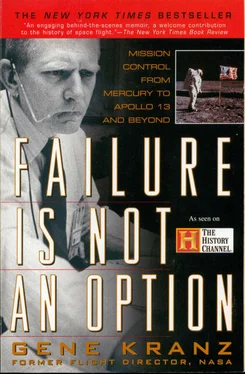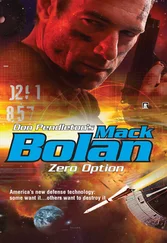The days remaining before the manned launch passed rapidly. Walt Williams gave the operation’s Go at the mission review on launch minus one day, May 1, 1961, and the capsule servicing began as we conducted our final simulations. We did our data checks and returned to the motel. Normally, I sleep like a dead man, but I tossed and turned most of the night.
Since I had spent most of my time with the team at the Cape in unmanned rocket testing, most of what I knew about the astronauts came from the newspapers. When I did see them, they seemed to live in a world apart from the rest of us, communicating only with the top managers and spending most of their time in hands-on training, learning all they could about their spacecraft and rockets. I didn’t blame them. The early space hardware had much in common with the imaginary technology in a Jules Verne science fiction novel. The capsule used steam-powered thrusters for control (the steam being generated by the reaction between hydrogen peroxide and a catalyst in a nickel chamber attached to the thrusters), a periscope for visual tracking, and an electric Earth globe for determining position. Half of the systems were primitive by today’s standards for aircraft avionics and control systems, while the other half were untested first-of-its-kind technology.
Their test pilot backgrounds made the Mercury Seven highly independent—and fiercely competitive. Each one of them was determined to be the first man in space; each believed his performance during the months of training and testing would win him the coveted prize. As launch time neared, Gilruth took the extraordinary step of asking each astronaut to rank all the others in the order of who was best qualified for the mission. Some thought he did this just to confirm his personal selection. Alan Shepard, Gus Grissom, and John Glenn were chosen from the seven; one of that trio would be the first among equals. Shortly thereafter Life magazine got into the act, dubbing the first three the Gold Team, the remainder the Red Team.
The brass felt a need to reassure the public there was no split in the ranks. Wally Schirra, Deke Slayton, Gordon Cooper, and Scott Carpenter stepped forward at a press conference a few days later to confirm that there was plenty to do and they all were still on one team, not divided into “red” or “gold” factions. Their reassuring words and smiles could not cover up the fact that someone else had indeed been chosen to be first. NASA did its best to soothe the egos of those who did not make the first cut. The lyrics to the music went like this: Each astronaut had an important role to play. There were plenty of flights for all. And, sure as hell, there was enough work to go around.
We in MCC were not surprised by the choice of Glenn, Grissom, and Shepard to make the initial flights. The controllers had worked briefly with all three, but only our bosses and the astronauts knew who would fly this very first mission. Since we had seen more of Shepard, we were betting on Al. The media seemed to favor Glenn. In part it was his image as a God-fearing, clean-cut American patriot and good family man. But journalists may have reported this in hopes of provoking someone into saying who it would be.
Shorty Powers, a lieutenant colonel in the Air Force, was the man in charge of public relations and the “voice of Mercury Control.” To Shorty, dealing with the press was just like a game of poker: never let on what is in your hand—and try to bluff them into showing you theirs.
Like Williams, Shorty never seemed to sleep and his exhausting work schedule only compounded his irritability; it took very little provocation to make him lose his temper. When he did, it was like a launch, a great deal of energy and noise expended amid the fire and smoke. He was a bantam cock of a guy, about five-foot-four or-five, always dapper and a bit of a strutter. For the most part, Powers had an unenviable job, setting up a public relations barrier behind which the engineers and the astronauts could work in peace, while at the same time trying to feed reporters’ insatiable demands for information. He really needed two sets of astronauts, one to do the mission, the other to perform for the media.
The astronauts and controllers stayed at the Holiday Inn at Cocoa Beach. It was not unusual to see Walt Williams charging into the bar late at night to get an answer to a problem from one of the controllers or engineers. He was likely to find the man he wanted there, because all of us sat around and chewed over rules and procedures endlessly and tuned in on Williams’s questioning to get the latest word.
We knew that three days prior to the launch the selected astronaut would check out of the Holiday Inn and quietly try to move out to the crew quarters at the Cape. Reporters hung around the Holiday Inn fishing for information, striking up a conversation, occasionally trying to pass as a member of the launch team. The press, which had become somewhat negative and adversarial after the Gagarin flight and the Atlas 3 failure, was now caught up in the excitement of this new chapter. Realizing that a man’s life and the future of the program were at stake, their coverage finally began to capture the excitement and suspense surrounding the imminent mission. The control team, taking our lead from Powers, neither confirmed nor denied any of the press speculation and ignored all the rumors that buzzed around the program like a swarm of busy bees.
The weather was stormy at midnight on May 2, 1961, when the control team arrived to support the initial check-out. The countdown progressed through the fueling of the Redstone while the launch team held the transfer van (used to move the suited astronaut from the hangar to the launch pad) at the hangar until the weather improved, or the launch was scrubbed
We had adopted the call sign “Freedom 7” during our final training runs, but I never knew who had named the capsule. Just one week after the Mercury-Atlas 3 failure we were once again in Mercury Control counting down to launch for our first manned mission. The headlines read: “AS HOP NEARS ASTRONAUT X IN SECLUSION.” Soon the world would find out—and so would we. I think only Kraft, Willams, and the flight surgeon knew it was Shepard. It had been decided in Washington that the identity of the first man would remain a secret until he stepped forward to climb atop the rocket.
The Russians did not announce any launch in advance; in fact they didn’t release any news about their manned spacecraft effort until they were good and ready, and even then they gave only carefully selected details about a flight. They could do this quite easily in a closed society in which news was strictly controlled by the government. We did not have this luxury. From its earliest days, NASA had followed a policy of maximum, though prudent, disclosure. We had to do everything openly—and soon under intensive, live TV coverage. In their own good time, the Soviets had announced that Gagarin spent 108 minutes in orbit before returning safely to Earth in a parachute-cushioned landing.
We wanted to catch up and we believed that, at last, we were ready to do it—at least for the first step, a suborbital mission of limited duration. Dressed in his silvery space suit, Alan Shepard stood behind the door of Hangar S. Outside, the van that would deliver him to the launch site waited, along with a large group of reporters and photographers who were eager to tell the world which astronaut would step through the door.
Lightning and rain had been playing about the Cape all morning, and when the clouds had not cleared by 7:25 A.M. local time, the flight was canceled. No one could be responsible for the weather, but it struck us as another in an unending series of tough breaks. Who would stop the rain?
Читать дальше












